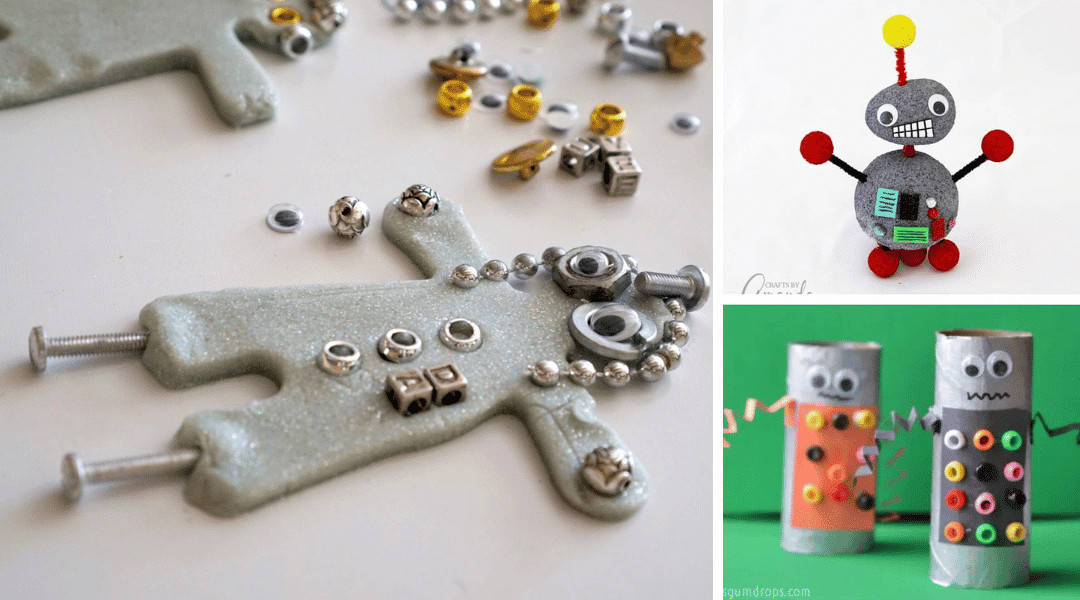Engage Your Child’s Imagination: The Ultimate Robot Craft Guide for Creative Kids
Welcome, awesome parents and craft enthusiasts! If you’re looking to dive into a world of creativity, fun, and learning with your kids, you’ve landed in the perfect spot. Our Ultimate Robot Craft Guide for Creative Kids is here to ignite the imaginations of your little ones and transform your crafting time into an unforgettable adventure. In today’s tech-inspired age, what could be more exciting than crafting your very own robot companion?
Why Robot Craft is the Perfect Activity for Your Kids
Before we embark on our crafting journey, let’s explore why robot craft makes for an excellent activity:
- Stimulates Creativity: Building a robot from scratch encourages out-of-the-box thinking and offers endless possibilities for customization.
- Develops Motor Skills: Fine motor skills are honed as children cut, glue, and assemble their robotic creations.
- Teaches Problem-Solving: As they figure out how to piece together their robots, kids learn valuable problem-solving skills.
- Introduces Basic Engineering: Through play, children gain an early understanding of simple engineering concepts.
- Educational Fun: Robot craft is a stealthy way to incorporate fun and education, from learning about robotics to exploring science fiction.
Materials You’ll Need for Your Robot Craft Project
Gearing up for some crafty construction? Here’s what you’ll need to get started:
- Cardboard boxes of various sizes
- Construction paper
- Aluminum foil
- Safety scissors
- Glue and tape
- Markers, paint, or crayons
- Miscellaneous craft supplies (pom-poms, googly eyes, pipe cleaners, etc.)
- Optional: LEDs, batteries, and simple circuits for an electrifying touch
Starting Your Robot Craft Adventure
We’ve gathered our materials, and now it’s time to switch on the fun! Follow these steps to jumpstart your robot craft project:
- Choose Your Robot Type: Decide with your child if you’ll be creating a humanoid robot, an animal-inspired bot, or maybe a totally unique design from their imagination.
- Plan Your Design: Sketch a rough outline or blueprint of your robot on paper. Decide which materials will go where, and consider the colors and features you want to include.
- Create a Solid Base: Start with a cardboard box as the body. You can use a smaller box for the head and other shapes for limbs. Ensure everything is secure with glue or tape.
- Add Details and Personal Touches: This is where the real fun begins! Decorate with aluminum foil for a metallic look, use construction paper to add details, and let your child personalize their robot with craft supplies.
- Bring it to Life: Once decorated, encourage your child to give their robot a name and create a story or background for their new companion.
Ensuring a Safe Crafting Experience
Safety first! Always supervise your children during craft time, especially when using scissors or working with small parts. Non-toxic materials and age-appropriate tools are key for a worry-free and enjoyable crafting session.
Beyond the Basics: Advanced Robot Craft Techniques
For those looking to elevate their robot craft experience:
- Introduce movable parts using brads or hinges.
- Incorporate recyclable materials like bottle caps and paper tubes.
- Experiment with basic electronics to add lights or movement.
As you and your kids venture into the imaginative world of robot craft, the potential for creativity is as limitless as the universe itself. Whether you’re making a miniature bot from household items or designing a full-scale cardboard automaton, the joy is in the journey—and the quality time spent together.
Stay tuned for more in-depth tutorials and ideas to take your robot craft to the next level. And remember, the most advanced technology of all is the imaginative power of a child at play!
Get ready to be the coolest craft commandos in the galaxy as you embark on this robotic crafting odyssey. Charge your creativity and let’s make some whimsical wired wonders!

5 Essential Preparation Tips for Robot Craft with Kids
Before you set off on your robot-building mission, here are five important considerations to ensure a successful crafting experience:
- Establish a Crafting Zone: Set aside a dedicated space for crafting. Cover the tables with newspapers or a tablecloth for easy cleanup. Make sure the area is well-lit and spacious enough for your child’s creativity to take flight.
- Organize Your Materials: Have all your materials sorted and within reach before you start. It can be helpful to use containers or ziplock bags to keep similar items together, such as all coloring materials, adhesives, or decorative bits and bobs.
- Time Management: Robot crafting can be engaging, but it’s important to estimate how much time you’ll need for the project. It might span over a few days, so plan accordingly and maybe create a mini-agenda with your child to build anticipation.
- Choose the Right Project for Your Child’s Age: Pick a robot craft that aligns with your child’s abilities. Younger children will enjoy simple designs with large pieces, while older kids can handle more intricate projects with movable parts or electronic elements.
- Prepare for Mess & Mistakes: Crafting can get messy, and that’s okay! Make sure your child knows that it’s a part of the fun and that mistakes are wonderful opportunities to learn and improve. Keep a positive attitude to encourage their efforts, regardless of the outcome.
With these tips under your belt, crafting a robot with your kids can become an enriching experience for the whole family. It’s not just about the final product; it’s about the memories you create, the skills they gain, and the smiles you share along the way.
Robot Craft Ideas for Different Age Groups
Unsure about what type of robot craft is suitable for various age groups? Here’s a quick rundown to spark those creative energy circuits:
- Toddlers (Ages 2-3): Focus on sensory play with large cardboard pieces and non-toxic paint. They can enjoy sticking on large buttons or pom-poms for robot features.
- Preschoolers (Ages 4-5): Introduce shapes and encourage them to name their robot parts. They can handle safety scissors with supervision, for a more hands-on experience.
- School-Age Children (Ages 6-10): They can start working on more complex designs with moving parts and enjoy personalizing with a wider range of materials.
- Tweens and Teens (Ages 11+): Present them with advanced projects that may include simple robotics kits or electronic components to bring their robots to life with light and movement.
Each child is unique, and these suggestions are meant to cater to typical developmental stages. Always tailor the activity to your child’s individual interests and skills to keep them fully engaged and excited about crafting.
Your robot crafting journey is embraced not only with cheerful enthusiasm but also with the promise of nurturing a budding interest in the world of robotics and engineering. Every snip, every stroke of paint, and every imaginative thought lays the groundwork for an enriching childhood filled with learning, fun, and, most importantly, love. So, gather those materials, roll up your sleeves, and embark on this spectacular robotic crafting quest with your kids!
See more great Things to Do with Kids in New Zealand here. For more information see here
Disclaimer
The articles available via our website provide general information only and we strongly urge readers to exercise caution and conduct their own thorough research and fact-checking. The information presented should not be taken as absolute truth, and, to the maximum extent permitted by law, we will not be held liable for any inaccuracies or errors in the content. It is essential for individuals to independently verify and validate the information before making any decisions or taking any actions based on the articles.




